Ondeh-Ondeh Recipe calls for glutinous rice flour infused with pandan leaves extract and filled with coconut palm sugar. These soft decadent balls are cooked in water and dredged with freshly grated coconut.
The recipe for Ondeh-Ondeh (also spelled Onde-Onde) in Singapore and Malaysia calls for glutinous rice flour. As a tourist visiting Singapore and Malaysia years ago, I did not try out these delicate desserts. I was more into the sightseeing aspects of the place, not to mention, the shopping. It was after getting married and living in South-East Asia that I got to appreciate these sweets up close.
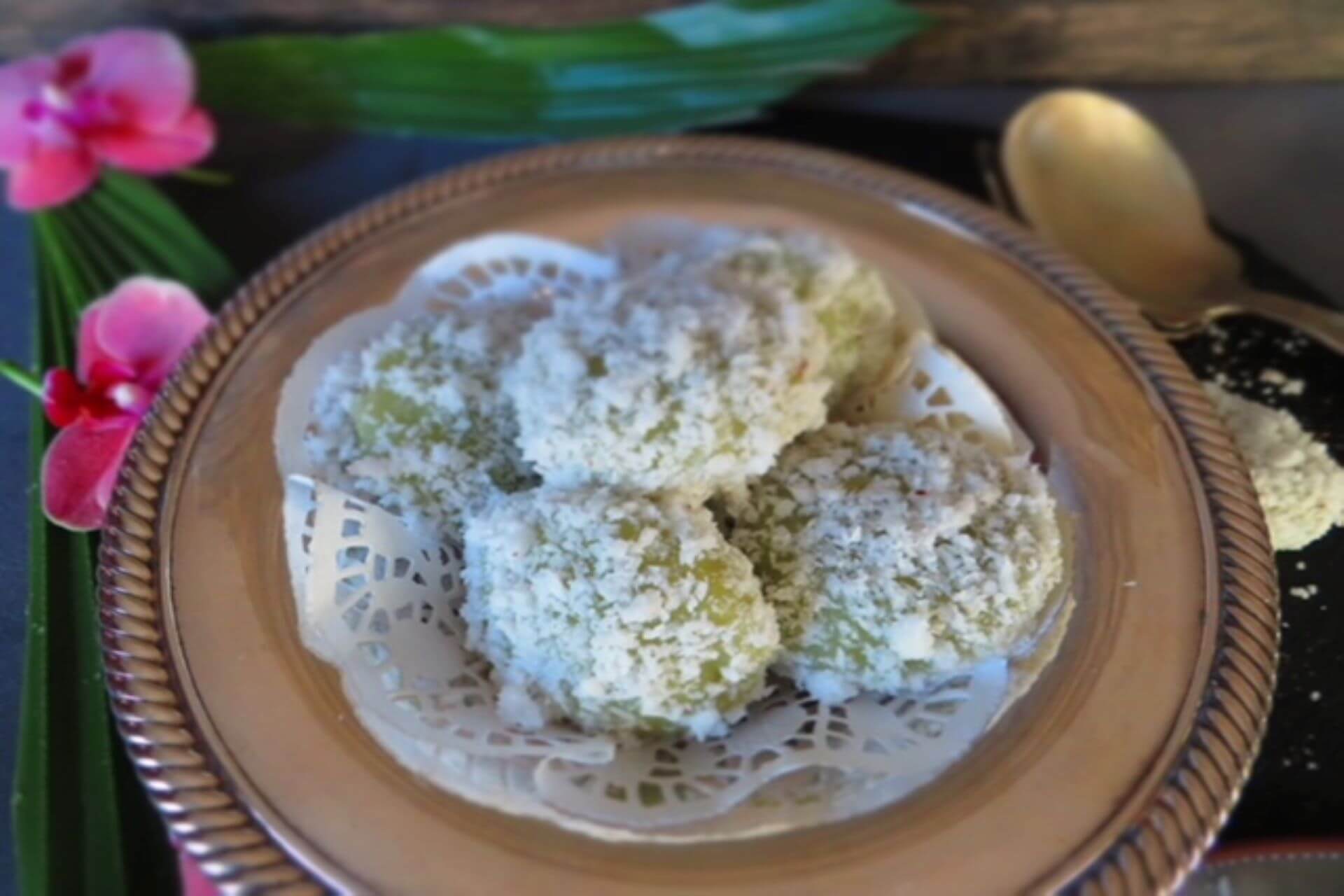
Ondeh-Ondeh is a true South-East Asian dessert. Whether it is called klepon in Indonesia or Ondeh-Ondeh in the Malay Peninsula, this kueh (cake) is basically glutinous rice flour balls that are infused with pandan flavor and filled with gula Melaka.
Be aware though, these desserts have a short shelf life because of the use of coconut which spoils easily. My kids instantly latched on to these desserts delighting in the rich, unique flavors, bright colors, and varied textures. I was incredibly surprised to find the traditionally Nyonya and Indonesian desserts at Siem Reap in Cambodia. While I was enjoying Cambodian cuisine, I was amazed to see this dessert sold at one of the restaurants close to the Floating Market.
But it was only when I was living in Colorado that the urge to create a recipe for the Ondeh-Ondeh struck me. We frequented a South-East Asian restaurant and became fast friends with the restaurateur. We enjoyed all the dishes on the menu for the restaurant was gracious enough to even make some dishes that we requested. It was one of those times when my kids were craving for kueh that the restaurateur’s mother indirectly shared the recipe with me. She cryptically informed me to use nine ounces of glutinous rice flour or a 2:1 ratio with tapioca flour.
I was aware that the balls needed to be boiled in water. There are so many Indian desserts that are encased with sugar or nuts and then boiled in water or sugar syrup. Intuitively, I elected the 2:1 ratio of glutinous rice flour and tapioca flour to make a dough using the pandan juice.
Ingredients:
- Pandan (Pandanus amaryllifolius) is a native South-East Asian plant that has a somewhat vanilla~ish flavor. It is more commonly called fragrant screw pine. However, I have not found a substitute for pandan, although you could use panadan essence.
- Gula Melaka is a type of palm sugar and is originally from Malaysia. You can make Ondeh-Ondeh using recipe with any kind of palm sugar. I used the coconut palm sugar for this recipe.
- Tapioca flour and glutinous rice flour: Glutinous rice flour is very sticky and both these flours are available at Asian stores.
- Coconut: Fresh coconut kernels are ideal for this dessert. Desiccated coconut is not a substitute.
This recipe for the Ondeh-Ondeh sweet is a genuine ‘burst in the mouth’ adventure. It is not like mochi or any other encased sweet. My kids like to pop the whole thing in their mouth and bite down so that they get that infusion of the palm sugar, pandan flavor, and shredded coconut all in one gooey explosion! You could also try my Bubur Chacha, another South-East Asian dessert made with coconut milk!
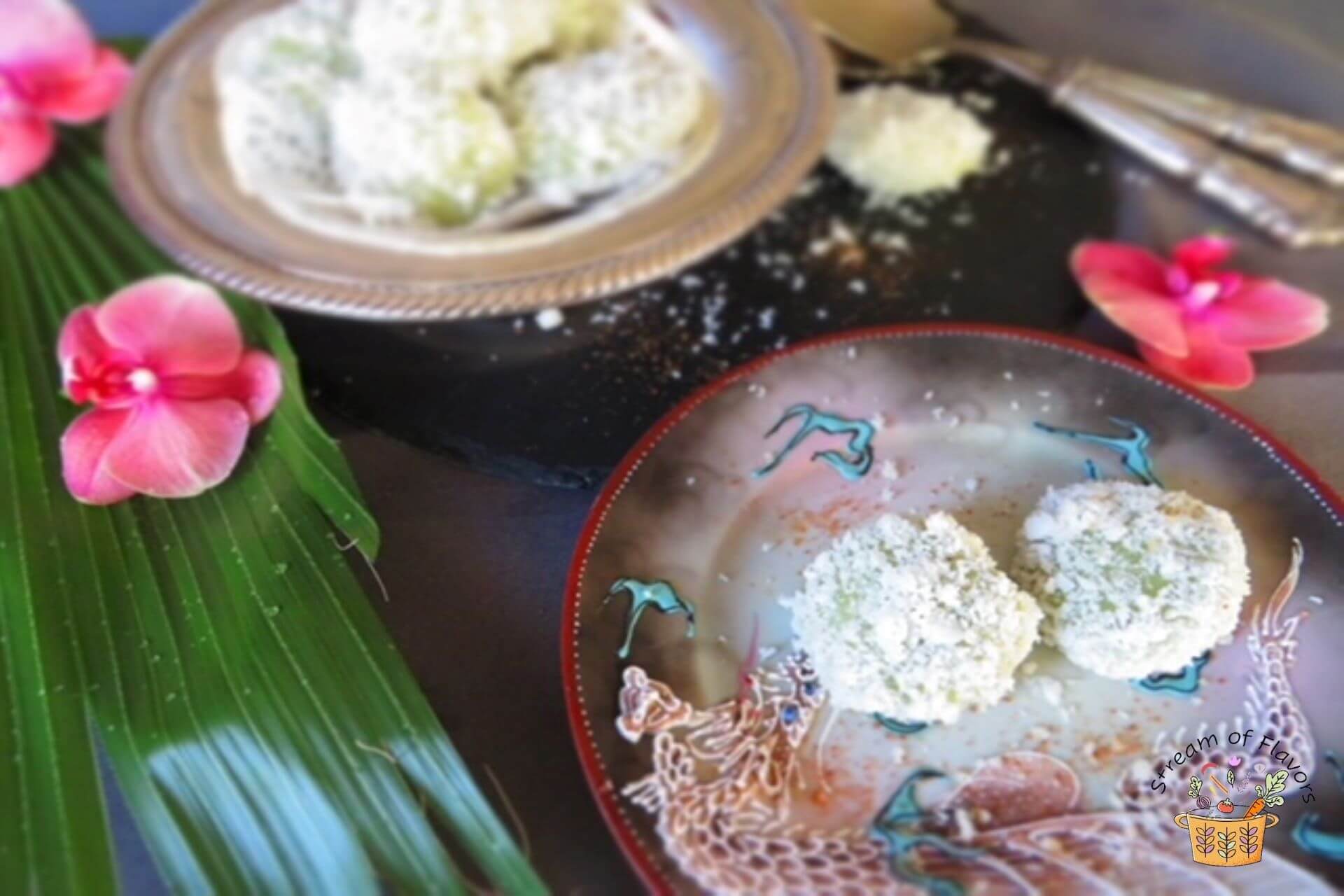
Recipe on how to make the Ondeh-Ondeh:
1. How to make the pandan juice:
- Wash the pandan leaves for 10 seconds under warm running water from the faucet. Cut them into smaller pieces and place them in a food processor with the water.
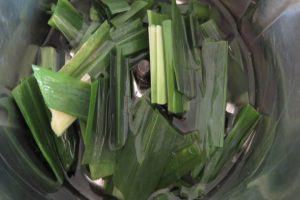
- Pulse the pandan and water together until fine.
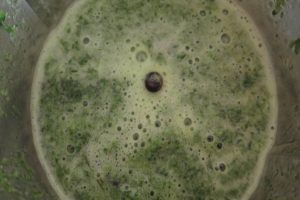
- Use a fine cheese cloth to extract the pandan juice and set aside.
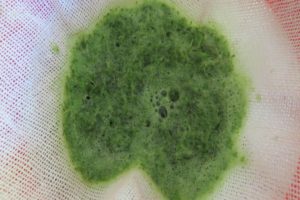
2. How to make the dough:
- Mix the tapioca and glutinous rice flour together and add the pandan juice.
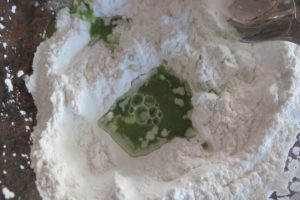
- Make a dough by kneading with the pandan juice.
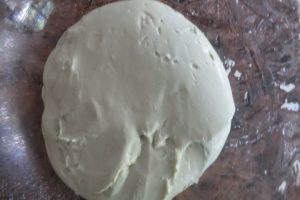
- Sprinkle a few drops of peanut oil and let it rest for 15 minutes in a bowl covered with a damp cloth.
3. How to make the balls:
- Divide the dough into 12 portions. Knead each part and flatten on your palms. (Grease your palms with oil and dust with a little glutinous flour) Do not make them too thin or too thick.
- Gently, cup your palm and fill the center with a teaspoon of coconut palm sugar. Pinch the edges together to make small balls without any holes that might let the palm sugar ooze out while boiling them.
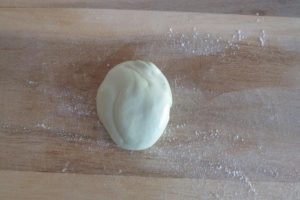
- Boil water in a big saucepan. Slide the prepared balls one at a time into the boiling water. When the balls float to the top, give them another two minutes to cook through. Use a slotted spoon to drain the water and remove the balls from the saucepan.
- Grate the fresh coconut using only the white part.
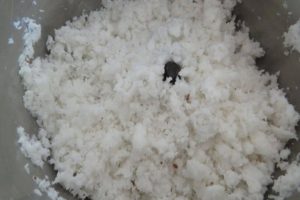
- Steam for 3 minutes sprinkled with 3/4 tsp of salt keep aside.
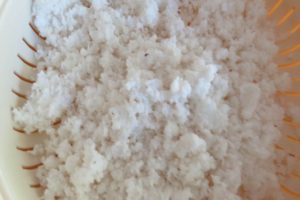
- Roll the balls on the steamed coconut and serve.
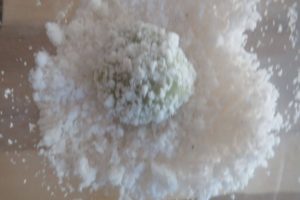
Here are some tips that I picked up through trial and error while making this dessert over the years.
- Never make the balls too thin or too thick. Too thick will give a rubbery texture, while too thin will break during cooking.
- Pandan (fresh or frozen) leaves lend a unique flavor compared to the extract.
- Food coloring is not essential as the Ondeh-Ondeh in this recipe will have a light green color from the pandan juice or extract.
- Boil the water before adding the balls. Drop one ball at a time so that the temperature of the water does not drop quickly. Wait for another two minutes after the balls have risen to the top.
- The cooked balls must be rolled on coconut immediately after removing from water.
- Stuff the balls with just enough sugar and do not overstuff the balls. The sugar can easily ooze out during cooking.
How to store:
The recipe for Ondeh-Ondeh uses fresh ingredients and is highly perishable due to the use of fresh coconut. Consume this dessert on the day of making it. Refrigerating the Ondeh-Ondeh does not taste good as the freshly made ones, and I do not recommend it.
Ondeh-Ondeh Recipe
Equipment
- Stovetop
Ingredients
For the Ondeh-Ondeh:
- 1 cup grated coconut only the white part of the kernel
- 8 pandan leaves (screw pine)
- 1 cup water scant
- 6 ozs glutinous rice flour
- 3 ozs tapioca flour
- ¾ cup coconut palm sugar (or gula melaka)
Instructions
How to make the pandan juice:
- Wash the pandan leaves for 10 seconds under warm running water from the faucet. Cut them into smaller pieces and place them in a food processor with the water.
- Pulse the pandan and water together until fine.
- Use a cheese cloth to extract the pandan juice and set aside.
How to make the dough for the Ondeh-Ondeh:
- Mix the tapioca and glutinous rice flour together and add the pandan juice.
- Make a dough by kneading with the pandan juice.
- Sprinkle a few drops of peanut oil and let it rest for 15 minutes in a bowl covered with a damp cloth.
How to make the balls for the Ondeh-Ondeh:
- Divide the dough into 12 portions. Knead each part and flatten on your palms. (Grease your palms with oil and dust with a little glutinous flour) Do not make them too thin or too thick.
- Gently, cup your palm and fill the center with a teaspoon of coconut palm sugar. Pinch the edges together to make small balls without any holes that might let the palm sugar ooze out while boiling them.
- Boil water in a big saucepan. Slide the prepared balls one at a time into the boiling water. When the balls float to the top, give them another two minutes to cook through. Use a slotted spoon to drain the water and remove the balls from the saucepan.
- Grate the fresh coconut using only the white part.
- Steam for 3 minutes sprinkled with 3/4 tsp of salt keep aside.
- Roll the balls on the steamed coconut and serve.
Notes
- You could substitute tapioca flour with only glutinous rice flour.
- If pandan leaves are hard to find, then use the extract mixed with water.
Nutrition


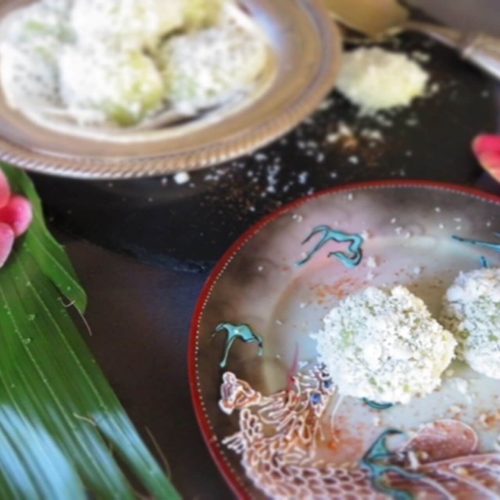
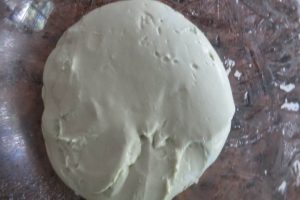
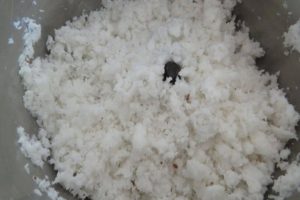
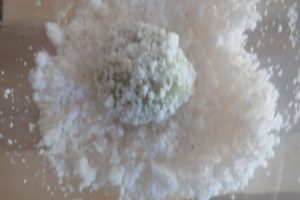





















This is one of my all-time favorite desserts! Love this recipe!
Glad you love it- thanks, Danya!
When I tried this at home, it turned out perfectly! Thanks for the note on the palm sugar, none of my balls burst at all!
One of my favorite desserts ever! Using fresh pandan instead of extract like other recipes tell you to really makes all the difference. It tastes just like what I’ve eaten in Singapore.
Thanks, Danya!